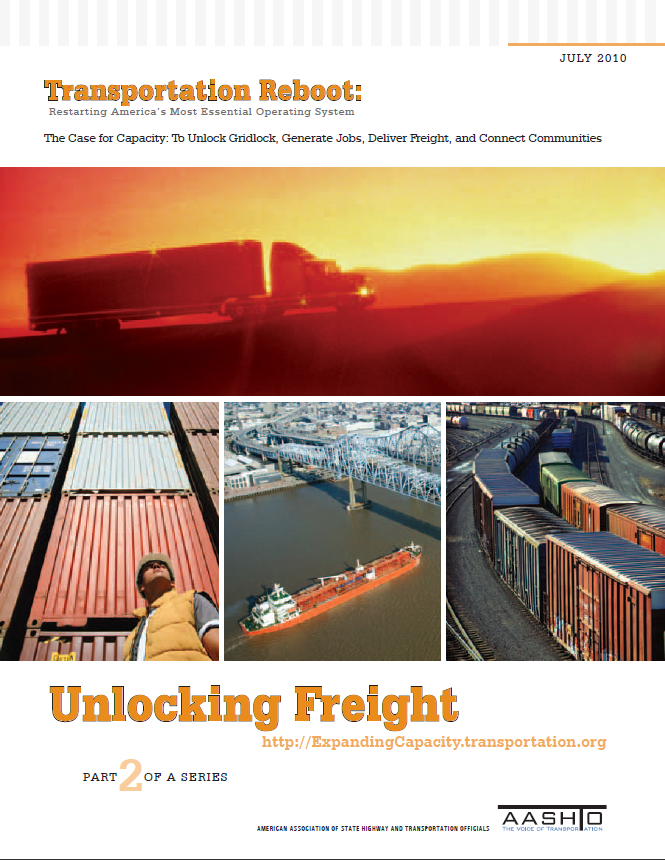(Cross posted on The Young Professionals in Transportation Blog)

Click the image to access the report
AASHTO released its latest report, Unlocking Freight, at a national news conference in Des Moines, Iowa, and at two regional news conferences in Tennessee and Pennsylvania on July 8th. The report includes new data, state examples of urgent capacity needs, and solutions to solve the pending transportation crisis in America’s freight system. The reports shows that investments are well below what are needed to maintain – much less improve – the movement of freight in this country. As a result, according to this report released, the transportation system that supports the movement of freight across America is facing a crisis.
The transportation system that supports the movement of freight across America is facing a crisis. Our highways, railroads, ports, and waterways require investment well beyond current levels to maintain – much less improve – their performance. Millions of jobs and our nation’s long-term economic health are at risk.
In 10 years, an additional 1.8 million trucks will be on the road; in 20 years, for every two trucks today, another one will be added. Already bottlenecks on major highways used by truckers every day are adding millions of dollars to the cost of food, goods, and manufacturing equipment for American consumers.
Unlocking Freight finds our highways, railroads, ports, waterways, and airports require investments well beyond current levels to maintain – much less improve – their performance. The report identifies key projects in 30 states that would improve freight delivery and dependability, and offers a three-point plan to address what is needed to relieve freight congestion, generate jobs and improve productivity.
Despite more long-distance freight being moved by intermodal rail, the report finds that trucks will still carry 74 percent of the load. On average, 10,500 trucks a day travel some segments of the Interstate Highway System today. By 2035, this will increase to 22,700 commercial trucks for these portions of the Interstate, with the most heavily used segments seeing upwards of 50,000 trucks a day. Yet between 1980 and 2006, traffic on the Interstate Highway System increased by 150 percent while Interstate capacity increased by only 15 percent. The report identifies the 1,000 miles of most heavily traveled highways used by trucks.
Each year, 147 million tons of freight pass through Tennessee by way of trucks, rail cars and barges. Nearly half of Tennessee’s Gross Domestic Product comes from the movement of goods and more than half of the statewide employment is in goods-dependent industries. The segment of I-40 through Tennessee and Arkansas alone accounts for nearly one-third of the nation’s busiest truck miles.
A current strain on the movement of freight in the Tri-State region is the lack of vehicular and rail crossings along the Mississippi River, according to Nicely. Tennessee, Mississippi and Arkansas are currently working to develop a third Mississippi River bridge crossing – dubbed the Southern Gateway Project. Environmental studies on the project are now underway and include consideration of a multi-use bridge that would include both vehicle and rail access.
Unlocking Freight is the second in a series of reports generated by AASHTO to identify the need to increase capacity in our transportation system. For more information and to see state examples of freight capacity needs, go tohttp://expandingcapacity.transportation.org.
To view the first report in the series, Unlocking Gridlock, go to http://expandingcapacity.transportation.org.


